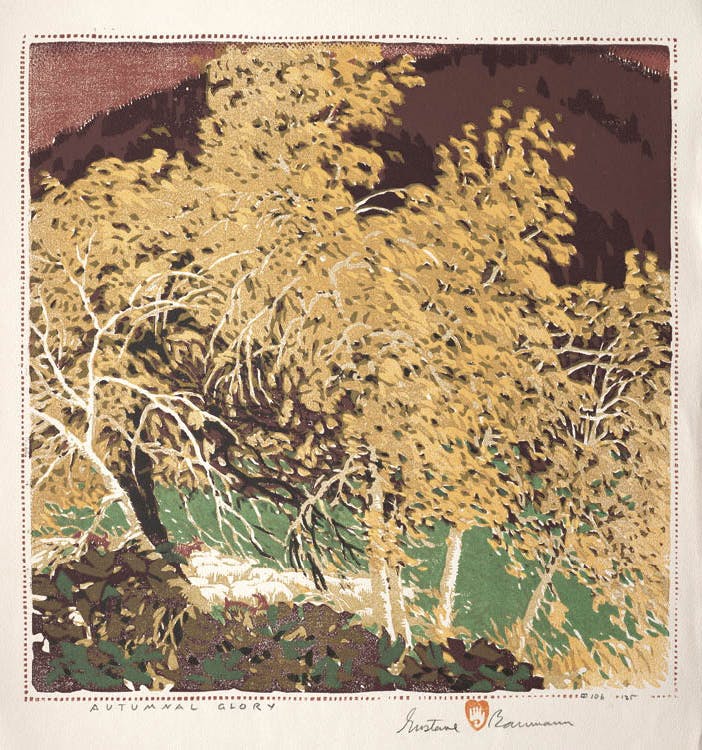
- Magazine Article
- Exhibitions
Colorful Cuts
A new show surveys printmaker Gustave Baumann's prolific career

Autumnal Glory 1920, printed 1953. Gustave Baumann (American, b. Germany, 1881–1971). Color woodcut; image: 33.3 x 32.9 cm. Gift of Ann Baumann, 2005.407. © Ann Baumann Trust
Gustave Baumann produced extraordinary color woodcuts during the first half of the 20th century. In 2005 the museum’s collection of Baumann’s work was enriched by a generous gift of 65 woodcuts and 26 drawings from the artist’s daughter, Ann Baumann. With works spanning 1908 to 1962, the donation provides a comprehensive survey of the printmaker’s long, productive career and celebrates his outstanding sense of color, consummate craftsmanship, and sensitive response to the environment.
Born in Germany in 1881, Baumann and his family immigrated to Chicago when he was ten. Forced to leave school and work in commercial art at 16, he was finally able to attend Munich’s Royal School of Arts and Crafts in 1905, learning the technique of color linoleum cuts. After returning to Chicago and resuming a career in commercial art, Baumann began to produce color woodcuts. He honed his craft in Brown County, Indiana, where he moved in 1910. Captivated by the picturesque, hilly scenery and isolation, he stayed there six and a half years.
Filled with wanderlust, Baumann headed east in 1917, visiting Provincetown, Massachusetts; Wyoming, New York; New York City; and Boston. In 1918 he traveled to Taos, New Mexico, which had already become a mecca for artists. He also visited Santa Fe to see the one-man traveling exhibition of his color woodcuts that was on view at the new Museum of Fine Arts (and was also shown at the Cleveland Museum of Art). Mesmerized by the stunning scenery and the culture of the Southwest, the artist settled in Santa Fe, where he remained until his death in 1971.
Baumann was exhilarated by New Mexico’s exotic natural beauty and strong light, noting that “the palette and theories regarding color east of the Mississippi should all be tossed in the river as you cross the bridge.” To reproduce the effects of the clear, crystalline sunlight, he mixed pure, brilliant hues, overprinting them in layers, and juxtaposed complementary colors. Strong, flat tones and bold designs capture the intense light and arid atmosphere, simulating the ambiance of the enchanting, unique region.
The artist traveled widely in search of novel subjects for his prints. Trips to California resulted in striking color woodcuts of redwoods and eucalyptus trees, while the Malpais (badlands) inspired a scene of sandstone bluffs eroded by wind and water into eerie shapes. Closer to home, the Pecos Wilderness provided a seemingly unlimited supply of motifs, including stands of aspens, which turn golden in the fall. Autumnal Glory depicts the luminous foliage shimmering in the breeze, an unforgettable, dazzling sight.
Baumann first visited the Grand Canyon in 1919 and was awestruck by the dramatic light effects and exquisite colors, but found them elusive and frustrating to capture. “The atmosphere plays tricks and you see things that are not really there,” he commented. “It is an altogether bewildering place.” His complex, sophisticated color woodcut of this vast and magnificent site, however, creates the illusion of the expansive space of the canyon and a convincing effect of light playing over the rock formations. Baumann found his greatest inspiration in nature and was especially interested in the fleeting effects of weather and atmosphere. The result of using five blocks to print six colors, Grand Canyon portrays this remarkable place in the midst of an evanescent rainstorm.

In addition to the stunning landscape, Baumann appreciated the cultural diversity of Santa Fe. “The town as a whole gave me a feeling of a fairly well-adjusted mixture of Spanish and Anglo culture, with the Indian as an interrupted civilization still pervading it all,” he noted. “It made for a unique situation not likely to be found anywhere else.” Baumann had a deep respect for the traditions and customs of Native Americans. He collected the art produced at the pueblos and often attended ceremonial dances. While San Geronimo Taos depicts the annual celebration of the feast day of Saint Jerome at the Taos Pueblo, Roman Catholic Spanish colonial churches and other historical sites were also subjects of his prints.
Baumann was an exemplary craftsman who performed all the work of making woodcuts himself. He cut a block for each color, fabricated inks, chose paper carefully, and printed without assistants. In the exhibition, the printing process is illustrated by the woodblocks for Summer Clouds along with the color separation proofs and progressive proofs for the print. The artist’s working method is further illuminated by his drawings, the first step in his creative process. A perfectionist, Baumann experimented and often recut blocks or used different colors during the printing history of a subject. A second impression of San Geronimo Taos, printed eight years after the blocks were first cut, includes a new block that adds details and patterns to blankets and the clothing of Native Americans in the foreground.

Gustave Baumann: Colorful Cuts presents the scope of the artist’s work over a distinguished 60-year career. While the works on paper exemplify Baumann’s extraordinary vision and skill, his writings, quoted here and throughout the exhibition, reveal his inner life and thoughts about art. These vibrant woodcuts and tempera drawings reflect the artist’s world, a biography of sorts of his life, interests, and distinctive vision.